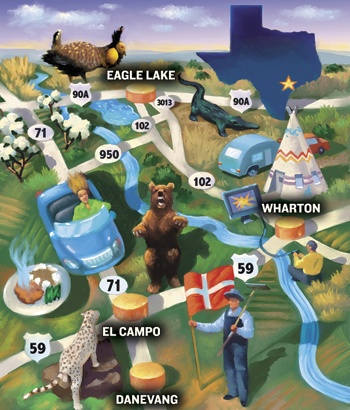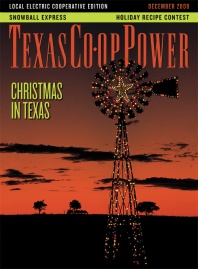Prairie grass once grew as tall as a horse’s belly on the Coastal Plains where land—and history—mean everything.
More than a century ago, this land meant survival for the Karankawas and Tonkawas and the early settlers who joined colonist Stephen F. Austin. It sustained cowboys, cattle, crops and the New York, Texas and Mexican Railroad.
I saw land and more land on a 75-mile tour of Colorado and Wharton counties that brought me face to face with the Coastal Plains’ rich history. I saw fields white with cotton and cattle grazing grasslands. And in the tallest grass of all, at the Attwater Prairie Chicken National Wildlife Refuge that’s served by San Bernard Electric Cooperative, I learned about the plight of an endangered bird on the brink of extinction.
EAGLE LAKE
Known locally as the Goose Hunting Capital of the World, historic Eagle Lake is marked on early Texas maps. The city, which is bisected by U.S. Highway 90A, preserves its history in the Prairie Edge Museum where what at the time might have been the longest alligator ever measured in Texas—a 13-foot, 8-inch beauty—is on mounted display. It was captured in the lake on the city’s edge in 1990.
Seven miles northeast of Eagle Lake on FM 3013, officials at the Attwater refuge are trying to keep a tiny population of birds alive. In 1890 there were 1 million Attwater’s prairie chickens. But as native grasslands disappeared, so did the birds. The 2008 spring count yielded 72 birds in the wild in Texas, including 52 at the Attwater refuge. Your best chance of seeing the reclusive birds at the refuge is during the Attwater’s Prairie Chicken Festival, tentatively set for April 4-5.
Eagle Lake Chamber of Commerce, (979) 234-2780, www.visiteaglelake.com
Attwater Prairie Chicken National Wildlife Refuge, (979) 234-3021, www.fws.gov/southwest/refuges/texas/attwater/index.html
EL CAMPO
From Eagle Lake, I drove scenic back roads—FM 3013 south, Matthews Store Road west, FM 102 south, FM 950 southwest and State Highway 71 southeast—to El Campo, headquarters for Wharton County Electric Cooperative.
El Campo’s beginnings—depicted in 24 murals around town—date to 1882, when a railroad camp called Prairie Switch sat where the city now stands. In 1890, Mexican cowboys renamed the railroad camp El Campo.
A surprising find is the El Campo Museum of Natural History, which features big-game animals from around the world mounted in life-size dioramas.
For good food, try the Fire House Bar and Grill, inside the city’s former fire station built in 1925, and Greek Bros. Oyster Bar and Saloon. Fire House serves up a tender ribeye chicken-fried steak that I cut with my fork. I also recommend Greek Bros.’s sautéed shrimp kicked up a notch with cayenne pepper.
El Campo Chamber of Commerce, (979) 543-2713, www.elcampochamber.com
El Campo Museum of Natural History, (979) 543-6885, www.elcampomuseum.com
WHARTON
Ever wanted to sleep inside a teepee? Well, you can at the Tee Pee Motel and RV Park, which first opened in 1942. The motel’s 10 concrete and stucco teepees, about 25 feet tall, feature the comforts of a regular hotel room, including a microwave, refrigerator and three windows.
Wharton, 14 miles northeast of El Campo on U.S. Highway 59, also shows off its history in murals and takes great pride in its restored courthouse that originally was built in 1889.
I had great fun at the 20th Century Technology Museum, a hands-on place where you can play 1970s and ’80s video games and see the evolution of a mind-boggling number of devices and appliances, from dishwashers to telephones.
Wharton Chamber of Commerce, (979) 532-1862, www.whartonchamber.com
Tee Pee Motel and RV Park, (979) 282-8474, www.teepeemotel.net
20th Century Technology Museum, (979) 282-8810, www.20thcenturytech.com
DANEVANG
Danevang—pronounced Dan-uh-vang —is about 22 miles southwest of Wharton and eight miles southeast of El Campo on State Highway 71. Named the Danish Capital of Texas by the state Legislature, this tiny farming community showcases its history in the Danish Heritage Museum. Danevang, which means Danish field, was established in 1894 as the first successful Danish community in Texas.
Danish Heritage Museum, (979) 578-0808
——————–
Camille Wheeler is the staff writer for Texas Co-op Power.


